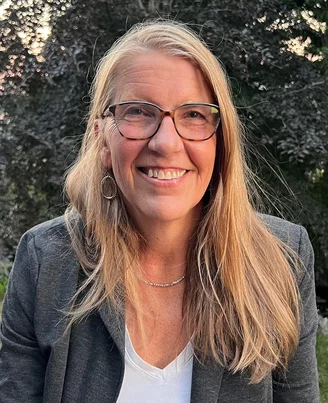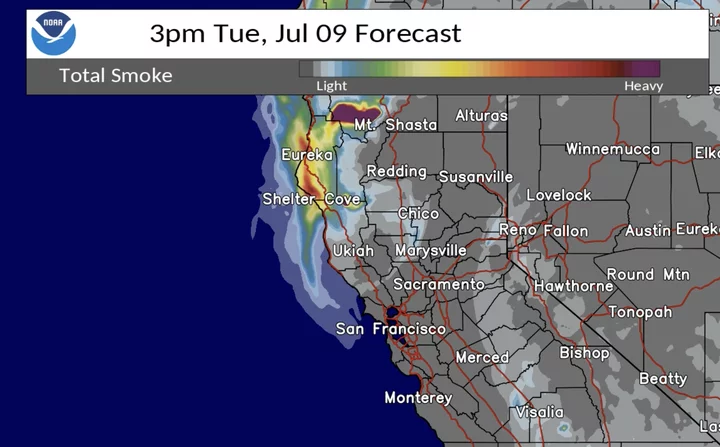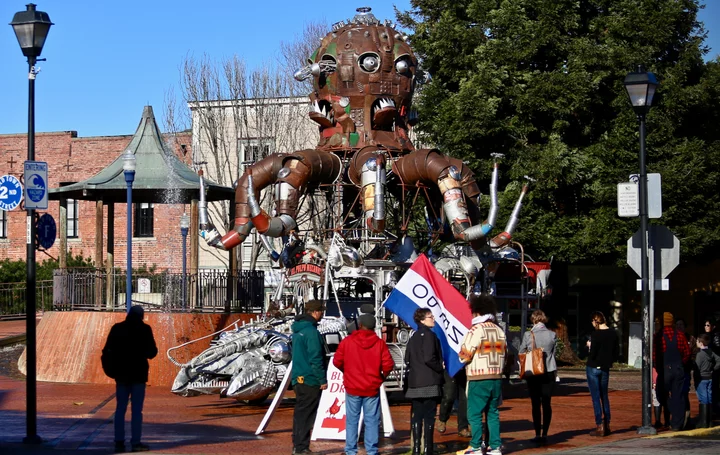The Supreme Court Took Powers Away From Federal Regulators. Do California Rules Offer a Backstop?
Ben Christopher / Wednesday, July 10, 2024 @ 7:37 a.m. / Sacramento
Photo by Mr. Kjetil Ree., CC BY-SA 3.0, via Wikimedia Commons
Tucked between headline-grabbing opinions on presidential immunity, Jan. 6 rioters and homeless encampments, the U.S. Supreme Court closed out a momentous session late last month with a series of body blows to the federal bureaucracy.
Under three back-to-back rulings, regulations that touch nearly every aspect of the American economy and American life (see: rules on food safety, water quality, overtime pay, medical billing, carbon emissions, fisheries monitoring and housing discrimination, to name a few) may soon be harder to enforce, more convenient to challenge in court and easier to strike down once challenged. For the conservative legal movement and for major business interests who bristle under what they see as an overreaching federal regulatory apparatus, the rulings mark a once-in-a-generation victory against the “administrative state.”
But in California, the effects of those rulings may be a bit more muted, legal experts say. California has an administrative state of its own.
From worker safeguards to water regulations to LGBTQ-protections on college campuses, the rules enforced by California state agencies often meet and exceed the stringency of their federal counterparts. If judges begin swatting down federal regulations as a result of the recent decisions, California’s own rules could serve as a regulatory backup.
For critics of the court’s recent decisions, that’s some consolation.
“California is, in a way, better situated than some other states because it is big enough and it has enough expertise in state government to actually provide state law protections that can kind of compensate for weakened federal ones,” said Sean Donahue, a lawyer who represents the Environmental Defense Fund. “That may not be true in some smaller states.”
California has plenty of practice playing the role of Blue State bulwark against federal regulatory shifts to the right. During the Trump administration, the state’s Democratic leaders beefed up many state rules in the face of real or anticipated rollbacks out of Washington.
But as the state discovered then, there is a limit to how far California can go its own way. Many federal statutes explicitly prohibit states from overriding them. Such federal preemption has been decreed by the courts in other cases.
“Sometimes yes, California can go on its own,” said Ashutosh Bhagwat, an administrative law professor at UC Davis. “Sometimes it absolutely can’t, and sometimes it’s complicated.”
Three rulings against the bureaucracy
In what may be the most consequential of the session’s three regulatory rulings, the court’s conservative majority swept aside a 40-year-old judicial rule of thumb, known as “Chevron deference.”
The concept, named for the 1984 case that spawned it, required judges to defer to a federal regulator’s interpretation of how to implement a Congressional statute. In a high school civics class version of government, Congress passes the laws and the executive branch, with the President sitting at the top, simply enforces them. But enforcement is rarely simple. Congressional laws can be vague or fail to anticipate every eventuality, technological development or unforeseen problem. Since the New Deal, the federal government’s powers and responsibilities have expanded and grown more complex.
Chevron deference is the notion that if a statute is ambiguous and an agency’s interpretation is reasonable on its face, courts should let the bureaucracy call the shots.
No more.
In his opinion, Supreme Court Chief Justice John Roberts wrote that courts may “respect” federal agency expertise, but cannot automatically defer to it. “Agencies have no special competence in resolving statutory ambiguities. Courts do,” he wrote. The upshot: Regulated industries now have a better shot at successfully challenging the federal rules that govern them.
Building on the theme of putting a leash on federal bureaucrats, the majority also ruled against the Securities and Exchange Commission and put new limits on when agencies can use in-house administrative courts to levy fines, instead requiring agencies to take alleged rulebreakers to court.
In a third opinion, the Supreme Court ruled that the six-year statute of limitations for when an aggrieved business can challenge a federal regulation starts ticking whenever that suing party is first affected by the rule. Financial regulators in that case had argued that the shot clock starts when the rule itself is enacted, giving regulations a degree of finality once that time expires.
All three rulings were decided 6-3, with the court’s conservatives in the majority.
Climate change regulations especially vulnerable
In her dissent in the statute of limitations case, Justice Ketanji Brown Jackson, a Biden appointee, warned that together with the end of Chevron deference, the court’s rulings would unleash a “tsunami of lawsuits against agencies” with the “potential to devastate the functioning of the Federal Government.”
Legal experts are still debating just how consequential these rulings will be. Granting less flexibility to federal regulators and opening them up to the threat of indefinite legal challenge from regulated industries implicates an unknowably vast universe of rules. But no one knows which rules are most vulnerable until they wind up in court.
“We’ll probably see now a wave of litigation challenging regulations that many had thought of as being long-settled, and how that shakes out in terms of its application to California businesses and California residents and consumers, we just don’t know,” said Julia Stein, an environmental law professor at UCLA.
Climate change regulations may be especially ripe for challenge. Lacking much actual legislation on the subject from Congress, the Environmental Protection Agency has resorted to creative interpretations of old environmental statutes, like the 1970 Clean Air Act, to justify its rules governing greenhouse gas emissions.
Such creativity may no longer fly, at least with conservative judges.
“Agencies have no special competence in resolving statutory ambiguities. Courts do.”
— John Roberts, Chief Justice, U.S. Supreme Court
Federal regulators are “kind of hamstrung in the ability to take innovative approaches,” Stein said, now that the Chevron decision is history. “States, like California, are going to try to make up for that on the back end through their own authority and regulatory power, but it won’t be nearly as effective as if both those entities were working together.”
When a state can set its own rules isn’t always clear. Almost 60 years ago, Congress granted California the authority to set its own emission standards for vehicles. But a California mandate requiring major truck manufacturers to ramp up the sale of zero-emission vehicles might be an early test case, since experts are divided as to whether an interpretation of the Clean Air Act properly allows for such a law.
California, above and beyond
There are areas of the regulatory universe where California law clearly can, and often does, go far above what the feds require.
Labor law is one example.
Most California workplace laws are more protective of employees than federal rules. Not only is the state’s $16 minimum wage more than double that required nationwide, the state also maintains and enforces its own rules on overtime pay, independent contractor status, workplace discrimination and workplace safety.
Most recently, the federal Occupational Safety and Health Administration proposed a rule requiring employers to protect workers from heat illness. California’s own workplace safety agency has had such a rule in place since 2005 for outdoor workers and is expanding it to those working indoors this year.
Those rules will stand regardless of legal challenges at the federal level.
“California is, in a way, better situated than some other states.”
— Sean Donahue , Lawyer, Environmental Defense Fund
Such challenges are already on the way elsewhere. The same day the high court snagged final say over rulemaking from federal agencies, a Texas judge cited the Chevron-ending decision in putting a new Biden administration overtime rule on hold for state employees.
A long established stereotype of California would suggest that lawmakers here are already ideologically predisposed to out-red tape Washington. But many of California’s supercharged state rules are of recent vintage, born out of resistance to the Trump administration.
In 2019, then-California state Sen. Hannah-Beth Jackson authored a handful of laws to put the federal rules that govern gender discrimination in schools and universities into state statute. That was in anticipation of controversial changes to Title IX, a 1972 civil rights law, proposed by the Trump administration.
Federal education regulators have mined Title IX’s mere 37 words to justify regulations on everything from school sports to sexual assault reporting standards to scholarships.
Protections for wetlands and migratory birds and bans of certain pesticides were also ratcheted up in California during the Trump era.
But that blue state playbook didn’t always go as planned.
In 2019, San Diego Sen. Toni Atkins, then the top Democrat in the state Senate, authored a bill to anti-Trump “backstop, essentially copy-and-pasting the more stringent federal environmental and workplace rules from the Obama era onto the state’s books. Gov. Gavin Newsom vetoed that bill, calling it “a solution in search of a problem.”
California: A vision of life after Chevron?
The raft of rulings were momentous, but not especially surprising to many court watchers. The Supreme Court had been either ignoring or actively chipping away at Chevron deference for years.
That has some legal experts, even self-described liberals, skeptical that the final effect will be as dramatic as the Supreme Court’s liberal dissenters and many alarmed commentators have suggested.
“The major clean water and clean air acts were passed in the ‘70s, long before Chevron,” said Bhagwat at UC Davis. “There was administrative law before that. So, the idea that you can’t have administrative law without Chevron is stupid.”
Ironically, anyone looking to see what a post-Chevron world might look like could turn to California. State courts never adopted a Chevron-like rule in reviewing regulations. Instead, they’ve taken a more holistic approach, in which agency interpretations might be granted more weight when they’ve been consistent over time and are based on its own area of expertise. That, in effect, is pretty similar to the new rules of the federal road laid out last month by the U.S. Supreme Court.
“So when people say, ‘Oh, this is kind of the end of the world, abolishing Chevron,’ it’s like, well, it hasn’t been the end of the world in California,” said Keith Bishop, a partner with the law firm Allen Matkins who used to work as a California state financial regulator. “At least, not yet.”
“The law doesn’t matter that much anymore.”
— Ashutosh Bhagwat, law professor, UC Davis
Still, there are reasons to believe that certain courts outside of California will be keener to uproot regulations than they have been in California. That isn’t a result of differences in legal doctrine between courts, but of political philosophy, said David Carpenter, an appellate lawyer and partner at the law firm Sidley.
“In California, there would be a view that courts are going to be relatively more inclined to abide by or to follow or consider or give weight or respect to agency interpretations,” he said. “Depending on what jurisdiction the challenge is raised in, you might expect more hostility between the federal court and whichever administration is in power.”
Bhagwat shares the view that the outcome of a regulatory challenge will depend largely on the ideology of a given judge or court. That has led him to offer a less dramatic forecast of the law after this year’s spate of anti-regulatory rulings. “They were ignoring Chevron anyway,” he said. But it has led him to a much more dramatic and darker view of the law in general.
“We’re seeing the judiciary starting to reflect the polarization generally in American society,” he said. “There’s this sort of brutal reality on the ground, which is that the law doesn’t matter that much anymore.”
###
Rachel Becker and Jeanne Kuang contributed reporting to this story.
CalMatters.org is a nonprofit, nonpartisan media venture explaining California policies and politics.
BOOKED
Today: 6 felonies, 7 misdemeanors, 0 infractions
JUDGED
Humboldt County Superior Court Calendar: Today
CHP REPORTS
Us101 / Endert Beach Rd (HM office): Trfc Collision-Minor Inj
3639 Greenwood Heights Dr (HM office): Trfc Collision-No Inj
ELSEWHERE
County of Humboldt Meetings: Humboldt County Behavioral Health Board Meeting - Jan. 22, 2025
KINS’s Talk Shop: Talkshop January 13th, 2026 – Yana Valechovic
County of Humboldt Meetings: Jan. 14, 2025 - Humboldt Housing and Homelessness Coalition Executive Committee meeting
County of Humboldt Meetings: Humboldt County Behavioral Health Board Meeting - Jan. 22, 2025
OBITUARY: Aaron ‘Tank’ Abbott, 1992-2024
LoCO Staff / Wednesday, July 10, 2024 @ 7:26 a.m. / Obits
Aaron Abbott went
onto his spiritual journey on June 30, 2024, in Eureka at the age of
32. Aaron was born in Nevada to Aaron and Nancy Abbott, and
eventually the family relocated to Humboldt County. Aaron was a
Yurok tribal member and the grandson of Charles “Bill” Abbott,
who was the original member and creator of the transition team that
helped establish the Yurok Tribe.
Throughout highschool, he enjoyed sports, especially football. Shortly after high school, Aaron began working for UPS, where he maintained his career and enjoyed his financial stability to care for his son and enjoy his extracurricular activities with friends and family.
Aaron was a wonderful and loving father to his son, Weston Abbott.
He is survived by his grandmother Sue Henderson, father, Aaron Abbott Sr.; his brother, Warren; his sister, Jessica; and his beloved nieces and nephews, aunts Charlene Abbott-White, Bonnie Zinda, Karen Marshall, Karen Blake~Reed, uncles Charles and Kyle Abbott and several cousins and relatives and of course his girlfriend Jenia, whom he adored and cared for. Aaron was preceded in death by his mother, Nancy Abbott, grandpa Charles “Bill” Abbott, great-grandmother Mae Abbott, grandfather Jerry Henderson.
Aaron was an amazing human being, full of charisma and positive energy, who impacted many lives. He loved to dance and was a highly motivated individual. He was a friend to many, a loving father, a wonderful brother, son, grandson, nephew, and cousin. Aaron will be greatly missed by all who knew and loved him.
The service will be held tomorrow, July 10, 2024, at 12 noon at the Awok Bonny Green Facility, located at 3400 Erie St, Eureka, CA 95501.
###
The obituary above was submitted on behalf of Aaron Abbot’s loved ones. The Lost Coast Outpost runs obituaries of Humboldt County residents at no charge. See guidelines here.
STRINGS ATTACHED: Eureka Symphony Names New Maestro of Management
LoCO Staff / Tuesday, July 9, 2024 @ 3:27 p.m. / Music
Eureka Symphony release:
The Eureka Symphony’s new 2024-2025 season will present not just an exciting new lineup of musical performances and special guests, but also a new general manager.
Nancy Stephenson, a long-time local community organizer, brings 45 years of experience collaborating with Humboldt County artists, musicians, businesses, nonprofits and local government agencies. Most recently with the Redwood Coast Energy Authority for six years as their Community Strategies Manager, Stephenson also coordinated the Arcata Bay Oyster Festival and all of Arcata Main Street’s programs.
Her passion for event planning, fundraising, marketing and outreach earned her a Humboldt Heroes Award in 2006. Others know her as a goldsmith, jewelry designer, graphic artist and photographer. Her enthusiasm, diverse skills, community relationships, and willingness to accept new challenges make her a good match for the Eureka Symphony and its future.
The Board of Directors conducted an extensive search and was impressed by Nancy’s diverse skill set, history of community engagement and passion for promoting the arts,” said Board President Keenan Pool. “With Nancy’s capacity for leading an organization and Carol’s artistic vision, we could not be more excited for the future of the Eureka Symphony.”
Please reach out to Nancy if you would like to chat, have a question, or perhaps volunteer or donate.
“Listening to live symphonic music immerses us in a personal journey that’s shaped by our individual perspectives and frame of mind, but we experience it alongside hundreds of others in the audience that we don’t even know. These experiences can have a bonding effect and may bring us closer as a community - enriched, inspired, and full of hope,” said Stephenson. “I want to nourish that potential. I’m honored to be able to work with Carol Jacobson, Eureka Symphony’s Artistic Director and Conductor, the distinguished Board of Directors, the experienced and devoted staff, volunteers, donors and sponsors and of course the musicians who make this all possible. We’ll be exploring new ways to bring this local treasure to a broader audience and be a catalyst for future generations.”
Both Stephenson and Jacobson feel they have struck a chord together.
“We are so thrilled to have Nancy on board with the Symphony. I am personally looking forward to working on exciting new ideas and projects with her,” Jacobson said.The Eureka Symphony holds two major fundraising events each year. The next one, “Prelude to the Season Gala,” will take place on September 29 to kick off the 2024-2025 season. Ticket holders will enjoy the Temporary Resonance Trio (Terrie Baune, violin; John Chernoff, piano; and Carol Jacobson, cello), hors d’oeuvres by Brett Shuler Fine Catering, wine, and Claire Bent with her ukulele. Mike McGuire will host a live auction.
The Eureka Symphony, a community orchestra founded in 1991, performs five concert sets each season, with music performed by hundreds of community members, often joined by special guest artists from around the world.
For information about performances, events, tickets, or financial support, go to eurekasymphony.org.
As Shelly Fire in Siskiyou County Spreads, Folks Should Prepare for Potential Smoke Impacts
Jacquelyn Opalach / Tuesday, July 9, 2024 @ 1:21 p.m. / Fire
National Weather Service screenshot.
###
PREVIOUSLY:
###
The Shelly Fire in Siskiyou County has nearly doubled in size since yesterday, spreading north and east over 6,216 acres as of this morning’s report. It is still zero percent contained.
Smoke forecasts today predict that areas in Humboldt might see air quality impacts from the fire. The government website AirNow fire and smoke map reports moderate air quality in eastern Humboldt, while a National Weather Service forecast shows smoke blowing across the county.
Reached by phone, Debra Harris, Burn Program & Wildfire Response Coordinator at the North Coast Unified Air Quality Management District, said that smoke is most likely to reach the Highway 96 corridor and nearby river drainages, based on current weather conditions and the fire’s activity and proximity.
“At this point I don’t anticipate smoke impact making it to the coast,” Harris said. The North Coast Unified Air Quality Management District is keeping a close eye on the situation and will likely issue a general info advisory soon, she added.
In the meantime, it’s not a bad idea to prepare for smoke, Harris said. She suggested designating a clean air room in your house, setting aside water and making a plan for pets.
“[It’s] always a plus when you can prepare ahead,” Harris said.
Here’s a tip sheet on how to prepare your home and your family for smoke impacts. Maybe download it! Chances are it’ll come in handy at some point this summer.
Photo via Inciweb.
Local Environment Groups Pledge to Oppose New Road Tax Unless it Includes ‘Substantial’ Funding for Public Transit
LoCO Staff / Tuesday, July 9, 2024 @ 1:11 p.m. / Transportation
File photo via Redwood Transit Authority.
Below is a statement signed by several local environmental organizations about the a proposed sales tax to support road repair, which could appear on the November ballot:
We are caught in a dilemma. Humboldt County owns and is responsible for maintaining 1,200 miles of roads. Most of these road miles are rural, providing access to a small number of residences and businesses. Taxes associated with these rural properties are not sufficient to pay to maintain the roads that reach them. Gas taxes are not enough, either. Thus, we have found ourselves a trap: We have too many roads and not enough revenue to maintain them.
The County’s solution has long been to subsidize roads using other sources of revenue, including a state funding program that should go to meeting our local unmet public transit needs — of which there are many. But none of these subsidies have been enough. Now the County is preparing another new sales tax to put toward ever-increasing road costs. You may have already received mailers from the County about this tax measure, covered with pictures of roads and natural disasters. As environmental leaders, we harbor concerns that without major changes, the new tax would be regressive and harmful to meaningful climate action.
For environmental voters, the tax measure looks like a plan to maintain an environmentally damaging status quo. Transportation is the largest emitter of greenhouse gas emissions in Humboldt County. As the draft Climate Action Plan acknowledges, reducing greenhouse gas emissions from transportation requires investing in a more balanced transportation system, and particularly increasing the use of public transit. Part of the difficulty in convincing people to take the bus is that we do not finance our transit system adequately, resulting in long wait times and poor service on the weekends and holidays. As stated earlier, the County already siphons away money from public transit to rural roads.
And despite Humboldt County’s auto-oriented transportation system, many local people don’t or can’t drive and rely on public transit instead. Many kids use public buses to get to school, seniors use transit to get to the grocery store and doctor’s appointments, and people with disabilities use transit to get to jobs and services. At least 15,000 adults in Humboldt County don’t have a driver’s license at all, and many lower-income community members lack reliable vehicle access and rely on transit for most of their transportation needs. But sales taxes hit these same low-income people the hardest. It strikes us as fundamentally unfair to ask our lower-income friends and neighbors to bear the burden of subsidizing a road system they don’t even use, primarily for the benefit of better-off residents, without getting something in return.
In short, a new sales tax that only funds roads would be both deeply inequitable and environmentally irresponsible. That’s why Humboldt’s environmental leaders will oppose the County’s tax measure unless a substantial amount of the revenue goes to support public transit.
And the County does need a substantial amount of dedicated local transit funding: we cannot be satisfied with whatever pennies may be left over after road projects are funded. For example, to serve more bus commuters–and to give existing riders the service they deserve–we need buses every 15 minutes at all stops between McKinleyville and Fortuna. That requires a commitment to meaningful local transit investment. For any tax measure to gain support from environmental voters, we insist on holistic transportation funding that meets the needs of both roads and transit.
Colin Fiske
Coalition for Responsible Transportation Priorities (CRTP)Tom Wheeler
Environmental Protection Information Center (EPIC)Melodie Meyer
Redwood Coalition for Climate and Environmental Responsibility (RCCER)Caroline Griffith
Northcoast Environmental CenterDan Chandler
350 Humboldt
Eureka Wants YOU! Do You Have What it Takes to be an Old Town Ambassador?
LoCO Staff / Tuesday, July 9, 2024 @ 11:55 a.m. / Our Culture
Can you explain this scene to tourists? You might qualify! File photo: Andrew Goff
Press release from the City of Eureka:
Uplift Eureka announces the launch of the Old Town Stewards Volunteer Program, inviting passionate individuals to join as community ambassadors in Eureka’s historic Old Town neighborhood this summer.
Modeled after successful ambassador programs in other cities, Volunteer Stewards will play a pivotal role in fostering goodwill and hospitality, offering guidance on local resources, and assisting both residents and visitors alike.
Volunteer Stewards will engage in various activities including greeting community members and visitors, providing directions and recommendations, collaborating with local businesses, and participating in beautification projects such as landscaping and litter cleanup. They will also connect residents with essential local resources and spearhead initiatives aimed at enhancing the Old Town community.
Beyond its immediate impact on Old Town, the program offers a platform for residents, businesses, community groups, and social service providers to collaborate with the city on neighborhood-level issues.
To learn more about becoming an Old Town Steward and to express interest, visit this link or contact OldTownStewards@eurekaca.gov.
California’s ‘Weak’ Job Market Propped Up by Public Money as Private Sector Sheds Jobs
Levi Sumagaysay / Tuesday, July 9, 2024 @ 7:35 a.m. / Sacramento
Nursing students Ashley Jensen, left, and Courtney Houtz practice injection procedures in the clinical skills lab at University of San Francisco in San Francisco, Calif. on Oct. 9, 2023. Health care is one of the areas that has added jobs since 2022. Photo by Amir Aziz for Calmatters.
Gains in public-sector and other jobs largely supported by public money have cloaked a dismal California labor market, which has seen a big decline of private-industry jobs since their post-pandemic peak, a new analysis shows.
The state Legislative Analyst’s Office looked at employment data from the U.S. Bureau of Labor Statistics through April, and concluded that private-sector industries in California have lost a total of 340,000 jobs since reaching their peak a couple of years ago.
The tech and finance industries led those losses. Jobs in the information sector — whose major employers include household names such as Google, Apple, Facebook and Disney — have declined 16% since their peak. There were more than 531,000 such jobs in July 2022, but 98,000 of those have gone away. Employment in the financial sector peaked at 500,000 jobs in December 2021, but it has lost 43,000 jobs, or 8%, since then.
Three other industries each saw a 3% drop in jobs since their peaks: business services, manufacturing, and transportation and warehousing. California has a 5.2% unemployment rate, the highest in the nation for the past four months.
Meanwhile, the health care and social-service industries have gained 240,000 jobs since September 2022, said Chas Alamo, principal fiscal and policy analyst for the Legislative Analyst’s Office, on Monday. Alamo said this industry includes private employers such as dentists, child care providers, vocational-rehabilitation centers and more, but is tightly linked to government spending, so his analysis groups these jobs with public-sector jobs, which have grown by 120,000 over the same period. His analysis was based on 12.5 million jobs in the private sector as of April, and a total of 5.5 million jobs about evenly split between the public and publicly supported sectors.
“The jobs picture since late 2022 has been weak,” Alamo told CalMatters, adding that state monthly jobs numbers should be “viewed with caution” because early revisions show the state did not actually add jobs last year, despite what monthly jobs reports said. Monthly jobs reports are based on surveys of businesses; revisions by federal agencies are based on states’ unemployment insurance data.
California is heavily dependent on revenue from personal income taxes, so the type of jobs that it loses or gains is important.
Brooke Armour, president of the California Center for Jobs and the Economy, said “all job growth is good.” But she added that “we’re losing high-wage jobs that help fund the (state) budget. We’re gaining hospitality and service jobs, which are low-wage jobs. We’ve hollowed out the middle-class jobs.”
The center is the information arm of the California Business Roundtable, an advocacy group that includes top executives of the state’s major employers. The group’s most recent analysis of employment data echoes Alamo’s assessment of the state’s job market. Though the center’s report mentions the group’s recurring complaints about the high costs of doing business in the state, it chalks up tech’s significant job losses mostly to the industry’s pandemic hiring sprees.
“What we’re looking at in tech jobs is a correction,” Armour said.
The center’s report said tech companies continue to prefer to remain in the tech hubs of Silicon Valley and the Bay Area. That is also important to the state’s coffers, which are becoming increasingly dependent on the stock-market performance of the tech industry.
“But while those tech companies are still here, are they growing here or are they growing elsewhere?” Armour asked. “We see a lot of them making investments outside California.”
As for whether the state’s sizable budget deficit could affect the job growth in public-sector jobs, Alamo of the Legislative Analyst’s Office said the public-sector industry also includes jobs supported by the federal government. And he said jobs in the health care and social-services industries are likely to continue to grow “despite state-budget challenges.”
###
CalMatters.org is a nonprofit, nonpartisan media venture explaining California policies and politics.








